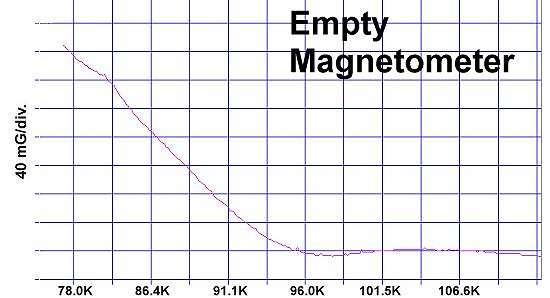



Superconductors.ORG recently discovered that copper is not required to achieve high-temperature superconductivity. YBCO was able to shed its copper chains and still remain superconductive as YBO. The lightest of the rare earths, scandium, was also found to be superconductive in this "truncated YBCO" structure. Now it's been found that trivalent metals that are not rare earths - like gallium, titanium and thallium - will also produce superconductivity in a copperless, ternary matrix. The above two magnetization plots show twin Meissner transitions for GaBa2Ox - one near 90 Kelvin and a weaker one around 101 Kelvin. A single Meissner transition appeared for TiBa2Ox near 77K. Then, below right is the magnetization plot for TlMg2Ox. It displays a majority phase transition near 81 Kelvin with a minority phase around 95K. The diamagnetic strength for the top two plots is around 160-180 milligauss, with TlMg2Ox producing the strongest signal at 220 milligauss. This suggests a volume fraction as high as legacy YBCO.



|

The first two of these discoveries each contained two heavy divalent metals and one light trivalent. In the third compound the configuration is reversed. It has two light divalents and one heavy trivalent. Reversing the arrangement does not seem to hinder superconductivity, so long as weight disparity is duly established across the oxygen ions. Since planar weight disparity was found to be a key component of high-temperature superconductivity in 2005, more than 130 new superconductors have been discovered. Click HERE to see the entire list. Below right is the magnetometer trace when empty. It explains the negative slope on the far left side of the test plots. 
|
Stoichiometric amounts of the below chemicals were used in the synthesis of these three compounds:
BaCO3 99.95% (Alfa Aesar) (decomposes to BaO during calcination)The chemical precursors were mixed, pelletized at 60,000 PSI and then sintered for 11+ hours at 880C. After sintering the pellet was annealed for 10+ hours at 500C in flowing O2. Testing temperatures were determined using an Omega type "T" thermocouple and precision OP77 DC amplifier. The magnetometer employed twin Honeywell SS94A1F Hall-effect sensors with a tandem sensitivity of 50 mv/Gauss.
RESEARCH NOTE: These materials can be strongly hygroscopic. All tests should be performed immediately after annealing.
RE-PUBLICATION NOTICE: Elsevier Publishing, dba Elsevier Science, as well as Morris Communications, both print and broadcast divisions, are specifically prohibited from re-publishing any part of this news story.
E. Joe Eck
© 2016 Superconductors.ORG
All rights reserved.
 BACK to "News" page at Superconductors.ORG
BACK to "News" page at Superconductors.ORG